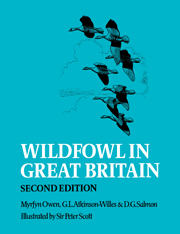Book contents
- Frontmatter
- Contents
- List of location maps
- Foreword by William Wilkinson
- Acknowledgements
- Conventions and abbreviations
- Part I Introduction
- Part II The survey of wildfowl habitat and distribution
- Part III Species accounts
- Part IV The conservation of wildfowl and their habitats
- Introduction
- The influence of man
- The management of stocks
- Conservation
- Conclusion
- References
- Indexes
The management of stocks
Published online by Cambridge University Press: 04 August 2010
- Frontmatter
- Contents
- List of location maps
- Foreword by William Wilkinson
- Acknowledgements
- Conventions and abbreviations
- Part I Introduction
- Part II The survey of wildfowl habitat and distribution
- Part III Species accounts
- Part IV The conservation of wildfowl and their habitats
- Introduction
- The influence of man
- The management of stocks
- Conservation
- Conclusion
- References
- Indexes
Summary
Supplementing wild populations
Ducks lay large clutches and often re-lay if the first clutch is lost. The eggs of most species are easy to hatch in incubators, under hens or foster ducks, and the survival of ducklings is excellent under captive conditions. In the wild the weather, food shortage and competition take their toll and the brood is reduced from 8–12 at hatching to 2–4 at fledging. It would, therefore, be easy to increase the number of fledged young produced, by taking the first clutch of eggs (allowing the female to re-lay again), hatching and rearing them artificially, and releasing them onto the breeding area or similar habitat. This has been practised for centuries in Britain and intensively for decades in North America, with the aims of:
a) increasing the number of ducks available for autumn and winter shooting and
b) supplementing wild populations for future breeding seasons.
An additional aim of the WAGBI scheme in Britain (249) was
c) to encourage a responsible attitude to harvesting and an interest in conservation in every wildfowler.
Mallard originating from game-farm stock are not likely to behave like wild birds in either tameness or flying ability, so eggs taken from wild birds are preferable. If eggs are taken early the duck will re-lay and there will be a minimum loss to the wild birds. In North America young ducks are usually released at 6 weeks of age, two or three weeks before fledging, these doing better than older or younger ducklings (82). Nevertheless, losses of birds liberated in unprotected places are up to 30% between release and fledging (194).
- Type
- Chapter
- Information
- Wildfowl in Great Britain , pp. 518 - 525Publisher: Cambridge University PressPrint publication year: 1986



